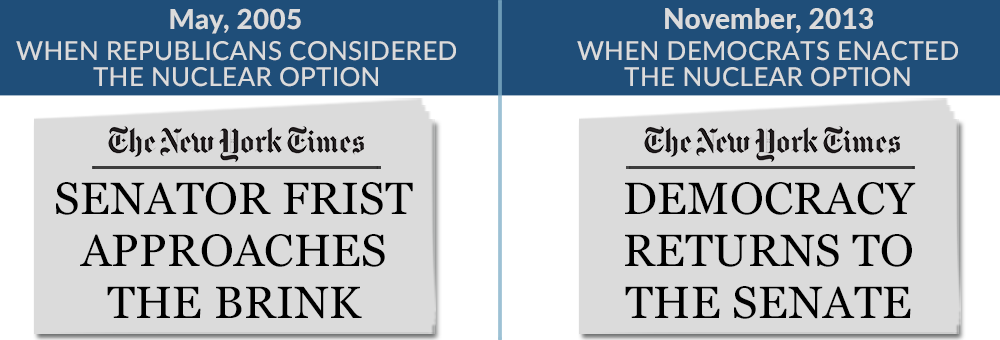A Double Standard on Nominations
-
Like Senate Democrats, the New York Times has a short memory and a flexible understanding of Senate procedure.
-
The editorial board’s statements on past confirmation battles show that its understanding of the Constitution and Senate practice depend on who is in office.
-
No matter what Senate Democrats and the Times may wish, the Constitution, historical practice, and their own words support giving the American people a voice in the future direction of the Supreme Court.
Like Senate Democrats, the New York Times editorial board appears to have a short memory and a flexible understanding of Senate procedure. Their views are not shaped by the Constitution, Senate rules, or past practice, but by who controls the Senate and White House.
ONLY ELECTIONS THAT DEMOCRATS WIN MATTER
The Times is attacking Senate Republicans’ principled decision to delay confirmation of a Supreme Court nominee until a new president is in office. Dismissing the argument that the American people should have a voice in the future direction of the court, the editorial board wrote in a February 25 editorial: “the people have already decided who should make this appointment: They elected Mr. Obama twice, by large margins.”
The newspaper had a different view of the importance of elections in 1987, when a Republican was in the White House. They argued then that it was the mid-term Senate election giving Democrats a majority that mattered.
“The President’s supporters insist vehemently that, having won the 1984 election, he has every right to try to change the Court’s direction. Yes, but the Democrats won the 1986 election, regaining control of the Senate, and they have every right to resist.” – New York Times, 10-05-1987
The editors of the Times appear to believe that only the elections won by Democrats count.
NEW YORK TIMES FILIBUSTER HYPOCRISY
The political calculations of the New York Times come as no surprise to those who watched the newspaper celebrate the destruction of the judicial filibuster in 2013. In 2005, when Republicans controlled the Senate and the White House, the newspaper had vigorously opposed the idea.
NYT editorial board contradicts itself on nuclear option

As majority Leader Frist discussed ending the judicial filibuster, the New York Times editorialized on Senate Democrats’ resistance: “This is a worthy fight, and the filibuster is a necessary weapon ... Clearly, uninhibited Senate debate in the deliberative stage, with the minority's voice preserved, is a crucial requirement.”
In 2013, when the roles were reversed, uninhibited debate was no longer a crucial requirement and the Times praised the nuclear option: “[T]he Constitution gives presidents the right to nominate top officials in their administration and name judges, and it says nothing about the ability of a Senate minority to stop them.”
GIVE THE PEOPLE A VOICE
Senate Democrats and their supporters at the New York Times protest Republicans’ choice on when to fill this Supreme Court vacancy because it does not serve their political interests. That does not erase their record on the issues. No matter what they might wish, the Constitution, history, and their own words support giving the American people a voice on the future direction of the Supreme Court.
Next Article Previous Article
